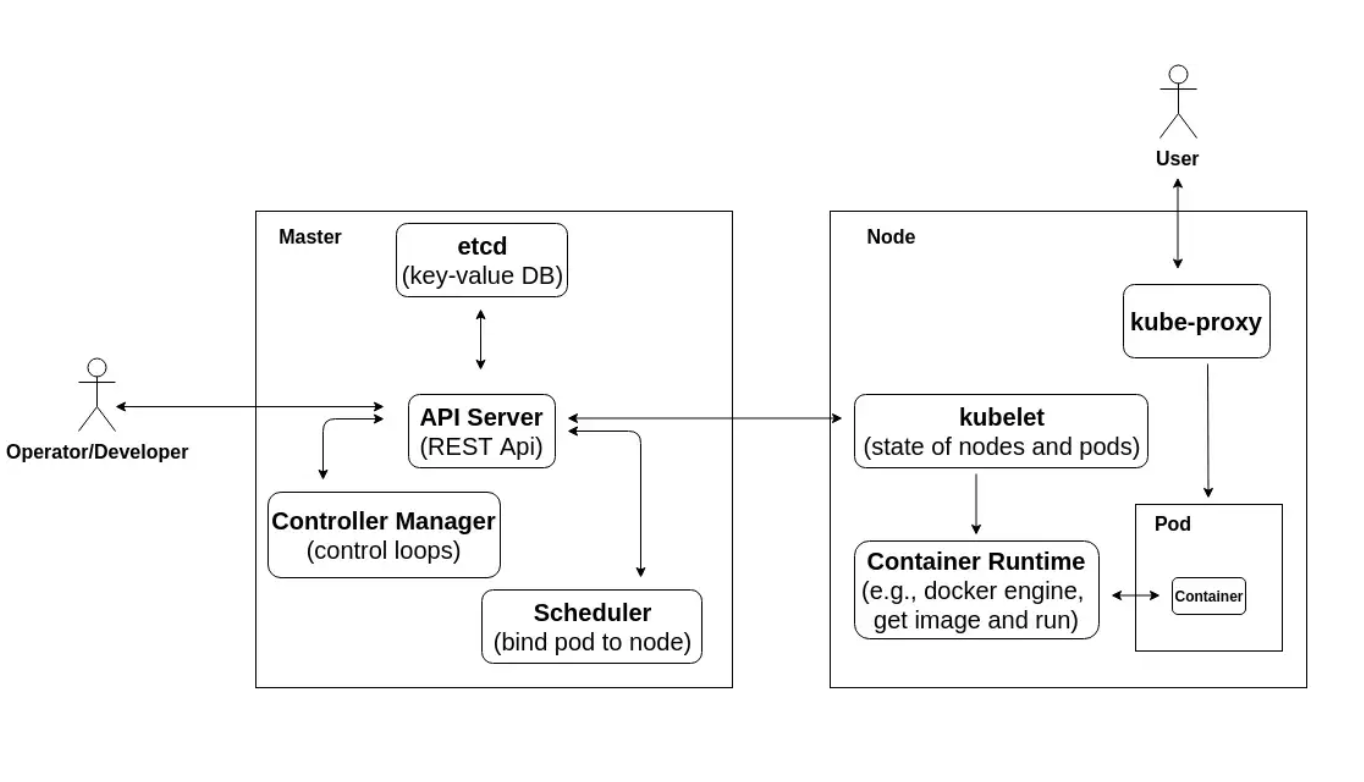Controller
- a control loop to describe a never-ending loop that tries to bring a system’s current state into the desired state, state is stored in ETCD.
- it tracks at least one kind of kubernetes resource and is responsible to bring the state of the existing resources to the desired state. it talks to API server for the current state and comparing it to desired ones
 (°0°)
(°0°)
API and objects
- object
A Kubernetes object is a “record of intent” - once you create the object, the Kubernetes system will constantly work to ensure that object exists.
We can think about object as a representation of ‘group + version + type’ , like ‘/api+v1+Pod’
object spec and object status - basic:
Pod
Service
Volume
Namespace -
controller objects:
ReplicaSet
Deployment
StatefulSet
Job - demo
apiVersion: xx kind: xxx metadata: xxx spec: xxx - API
API group is specificed in a REST path and in the apiVersion field of a serialized object. /apis/$GROUP_NAME/$VERSIONkubectl api-versions
Resource
resource, is an endpoint in the Kubernetes API that stores a collection of API objects of a certain kind.
/api/v1/pods resource -> a list of v1 pod objects
custom resource (CR), is an object that adds objects to the existing Kubernetes API or allows you to introduce your own API into a project or a cluster.
the state of a Kubernetes cluster is fully defined by the state of the resources it contains
kubectl api-resources -v 6
NAME SHORTNAMES APIVERSION NAMESPACED KIND
bindings v1 true Binding
componentstatuses cs v1 false ComponentStatus
configmaps cm v1 true ConfigMap
Objects
- Kind has three types: Objects, Lists, Op on objects(status, scale..)
- Objects are persistent entities in the Kubernetes system that represent an intent (desired state) and the status (actual state) of the cluster.
- Define
kind - a string that identifies the schema this object should have apiVersion - a string that identifies the version of the schema the object should have metadata.namespace - a string with the namespace (defaults to "default") metadata.name - a string that uniquely identifies this object within the current namespace metadata.uid - a unique in time and space value used to distinguish between objects with the same name that have been deleted and recreated. spec: desired state status: actual state - Object example
kubectl get --raw /api/v1/namespaces/AAA/pods/BBB
CRD
Defining a CRD object creates a new custom resource with a name and schema that you specify. The Kubernetes API serves and handles the storage of your custom resource. This frees you from writing your own API server to handle the custom resource, but the generic nature of the implementation means you have less flexibility than with API server aggregation
- deploying a CRD into the cluster causes the Kubernetes API server to begin serving the specified custom resource,
- with a CRD in place, users gain access to a significant subset of Kubernetes API functionality, such as CRUD, RBAC, lifecycle hooks, and garbage collection.
Operators
An Operator is an application-specific controller that extends the Kubernetes API to create, configure and manage instances of complex STATEFUL applications on behalf of a Kubernetes user.
An operator consists of two things:
One or more Kubernetes custom resource definitions, or CRDs. These describe to Kubernetes a new kind of resource, including what fields +++it should have. There may be multiple, for example etcd-cluster-operator has both EtcdCluster and EtcdPeer to encapsulate different +++concepts.
A running piece of software that reads the custom resources, and acts in response, usually a controller
Advantage of operators:
- handling updates from one version to another
- handling failure recovery if it’s needed, scaling the application up and down depending on use cases
-
without Operators, many applications need intervention to deploy, scale, reconfigure, upgrade, or recover from faults
- if you just want to add a resource to your Kubernetes cluster, then consider using Custom Resource Definition. They require less coding and rebasing.
- If you want to build an Extension API server, consider using apiserver-builder like kubebuilder.
kubebuilder
Kubebuilder is a framework for building Kubernetes APIs using custom resource definitions (CRDs).
kubebuilder
operator-sdk
The Operator SDK is a framework that uses the controller-runtime library to make writing operators easier by providing:
- High level APIs and abstractions to write the operational logic more intuitively
- Tools for scaffolding and code generation to bootstrap a new project fast
- Extensions to cover common Operator use cases